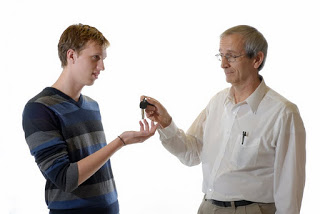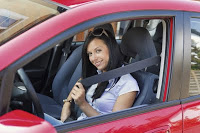Monthly Archives: August 2006

Is 16 Too Young to Drive?
August 28, 2006
On an average day in the USA, 10 teenagers are killed in teen-driven vehicles. This has caused many officials to question what age teens should be allowed to drive. OK- are you ready from some scary statistics? USA Today studied deadly crashes that took place during the year 2003. Of those accidents that involved drivers between the ages of 16-19, more people died throughout that year then for any disease or teen related injury. Are you ready for the numbers, how about 3,500 teenagers? That’s right, 3,500 teenagers died during the year 2003 from driver related accidents in teen driven vehicles. The statistics are frightening, and have caused many people to ask if teens really are ready to drive. Well, now it seems that science may be answering that question.
New scientific research has shown that the part of the brain that helps control impulsive behavior and helps rationalize the cause and effect of such behavior doesn’t fully develop until roughly the age of 25. You know how everyone says that teens believe they are immortal? Well, according to these studies, it’s true. But the reality is that we aren’t. And it is sad to say, but 3,500 teens in 2003 proved that they weren’t. So what are we to do?
Another point that the statistics show is that 16 year olds are involved in more fatal accidents and are worse drivers than all other teen drivers. In fact, states like New Jersey that restrict 16 year olds from driving have the lowest teen death rates in the entire country. There are a number of different reasons that make 16 year olds unsafe drivers and increase their chances of being involved in a fatal car crash. Some of these include:
- Sixteen year olds are inexperienced drivers. Many parts of the country, such as the South have unsafe streets, even for the most experienced drivers. Teens don’t have the skills to drive on these rural roads.
- Teens often drive vehicles that are prone to roll. SUVs, pickup trucks, and small cars top the list.
- Teens often drive after dark and with other teens in the car. This can cause serious distractions and make it difficult to use all of the senses needed to be a safe driver.
- Alcohol and speeding plays a vital role in many fatalities.
No matter how old you are you should take these things into consideration and drive safely and carefully. If you don’t feel comfortable, then don’t drive. Never drink and drive, don’t drive after dark, and stay away from unsafe roads. Also, limit the number of passengers that you allow in the car with you. Your life is more important than your popularity. Sure, if you are killed in a teen driven car crash your name will be in the paper, your friends, family members, even strangers will come to your funeral and remember you, and your school may hold a day of remembrance in your honor, but is that really the kind of popularity that you want? Play it safe and smart and use good judgment when driving.
This Driver’s Ed Program Gives Teens a Heart-Pounding Experience
August 21, 2006
You think you know it all when it comes to being behind the wheel of a car. However, after a lesson or two with this new driver’s education program for teens, you will figure out that maybe you didn’t know so much after all. The kicker is that teenagers, after some heart pounding moments, are enthusiastic about this program called Driver’s Edge.
It was started by a former race care driver named Jeff Payne. He mentions the fact that teens could ace Driver’s Ed but still have no clue how to handle a car during stressful times. With Driver’s Edge, teenagers are put through their paces, experiencing difficult driving situations. What do you do when your car goes into a skid? Many teenagers don’t really know and will overcompensate, sometimes causing an accident on the road.
Driver’s Edge will help you anticipate your moves in stressful situations. They will teach you how to carefully execute out of a skid. You will learn anti-lock braking and techniques on panic braking. Evasive lane-changing maneuvers are also on the agenda. It all sounds too cool doesn’t it, sort of like a James Bond or Fast and the Furious kind of thing. But it is real life and it will likely get your adrenaline pumping a bit.
While you would be behind the wheel of the car, a former race car driver and licensed instructor is beside you the entire time. Their job is to ensure that you don’t panic when faced with different stressful driving scenarios. They want you to act instinctively without over thinking it. Trial by fire in a controlled setting is the best way for teens to learn how to handle themselves behind the wheel of a car and avoid accidents. And we all know how the parents are going to get if that happens!
Read more driver education news in the Safe Driving Teen Monthly Bulletin. Each month the National Safety Commission publishes the bulletin for teens and parents designed to improve teen driver behavior, attitude, skills, and experience. Subscription Details

Unbelted Teen Killed in Crash
August 3, 2006
Missouri teen Charles “Charlie” J. Glik, 16, was driving at about 3 a.m. when his car left the roadway and struck a utility pole, police said. The impact snapped the pole in half, and Charlie, who was not wearing his seat belt, died at the scene..
Source: stltoday.com
Safe Driving Lesson Learned
In 28 of the states with belt use laws in 2004, the law specified secondary enforcement. That is, police officers are permitted to write a citation only after a vehicle is stopped for some other traffic infraction.
As of December 2004, 49 states and the District of Columbia had belt use laws in effect. The laws differ from state to state, according to the type and age of the vehicle, occupant seating position, etc.
Research has found that lap/shoulder safety belts, when used, reduce the risk of fatal injury to frontseat passenger car occupants by 45 percent and the risk of moderate-to-critical injury by 50 percent. For light truck occupants, safety belts reduce the risk of fatal injury by 60 percent and moderate-tocritical injury by 65 percent.
Among passenger vehicle occupants over 4 years old, safety belts saved an estimated 15,434 lives in 2004.
Wear your safety belt and shoulder harness properly. In a crash, you are far more likely to be killed if you are not wearing a safety belt. Wearing shoulder belts and lap belts make your chances of living through a crash twice as good.
Airbags, combined with lap/shoulder safety belts, offer the most effective safety protection available today for passenger vehicle occupants. Research indicates an overall fatality-reducing effectiveness for airbags of 11 percent when a safety belt is used in conjunction with the airbag. In 2004, an estimated 2,647 lives were saved by airbags.
This post is an excerpt from a recent edition of the Safe Driving Teen Monthly Bulletin. Each month the National Safety Commission publishes the bulletin for teens and parents designed to improve teen driver behavior, attitude, skills, and experience. Subscription Details

Text Messaging Cause of Fatal Teen Crash
August 3, 2006
A 17-year-old likely will face misdemeanor charges after allegedly losing control of his car while text messaging and hitting a bicyclist.
The bicyclist, Jim R. Price of Highlands Ranch, died Friday, two days after the accident.
The spokesman for Douglas County Sheriff’s Office stated that the driver could face a charge of careless driving resulting in death. Under Colorado law, the teen could face up to a year in prison.
Source: USAToday.com
Safe Driving Lesson Learned
Distracted driving: According to a 2002 NHTSA/Gallup Poll, drivers often allow their attention to be diverted from their driving by one or more of the following:
- Cellular phones: About 30% of all drivers use a cell phone while driving to make outgoing or incoming calls on at least some of their driving trips. An estimated 292,000 drivers were involved in a crash attributed to cell phone use between 1997 and 2002.
- Drowsiness: 37% of the driving population says they have nodded off for at least a moment or fallen asleep while driving at some time in their life. An estimated 7.5 million drivers have fallen asleep while driving during a given month.
- Dealing with children: Nearly one in four (24%) drivers deal with children in the back seat of the car while driving.
- Eating or drinking: Half of all drivers (49%) report eating or drinking at least occasionally while driving, with 14% doing so on three-quarters or more of their driving trips.
When you drive, don’t allow poor judgment or distractions to interfere with your driving. Put safety first!
This post is an excerpt from a recent edition of the Safe Driving Teen Monthly Bulletin. Each month the National Safety Commission publishes the bulletin for teens and parents designed to improve teen driver behavior, attitude, skills, and experience. Subscription Details

Car Surfing claims the life of Nashville Teen
August 1, 2006
Police say Shawn Nipper, 16, was car surfing on McGavock Pike in Two Rivers Park on a Saturday night when he died.
Car surfing is where you stand on the roof of a moving car and try to keep your balance while the vehicle is moving. Police say it’s one of the most dangerous stunts you can pull with a car.
The victim’s family says this so-called car surfing is a dangerous, growing trend that parents need to be aware of before it claims more young lives.
Source: newschannel5.com
This post is an excerpt from a recent edition of the Safe Driving Teen Monthly Bulletin. Each month the National Safety Commission publishes the bulletin for teens and parents designed to improve teen driver behavior, attitude, skills, and experience. Subscription Details
